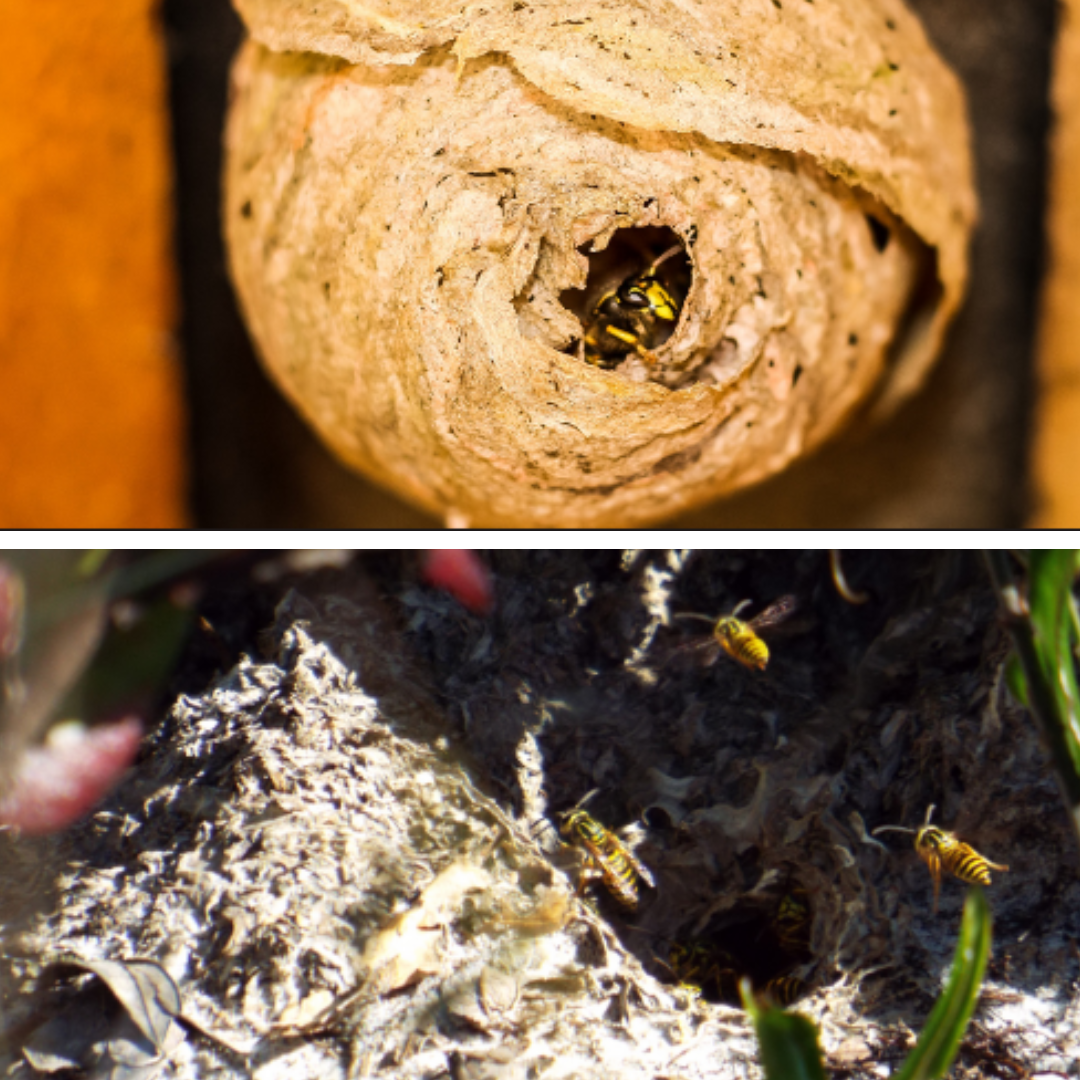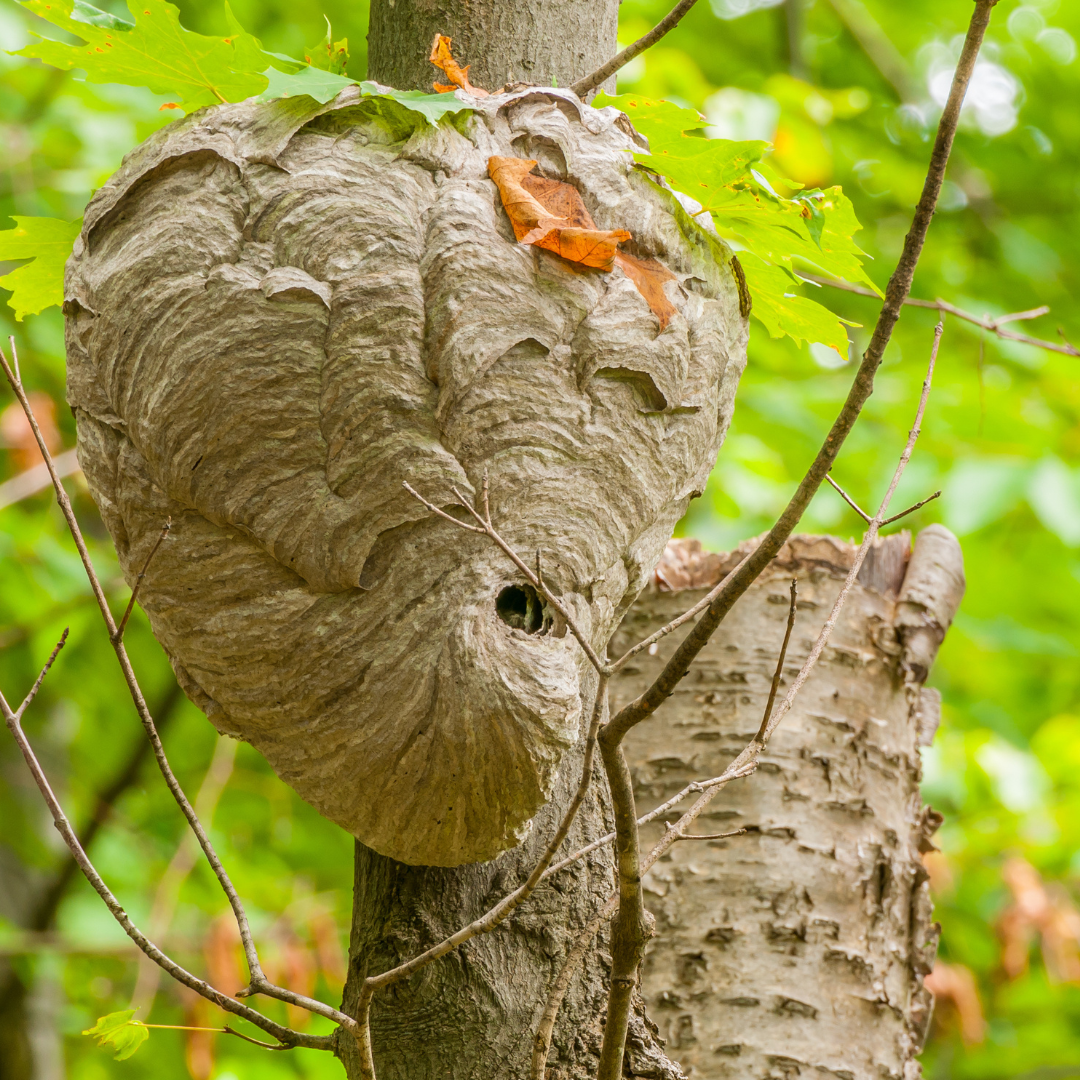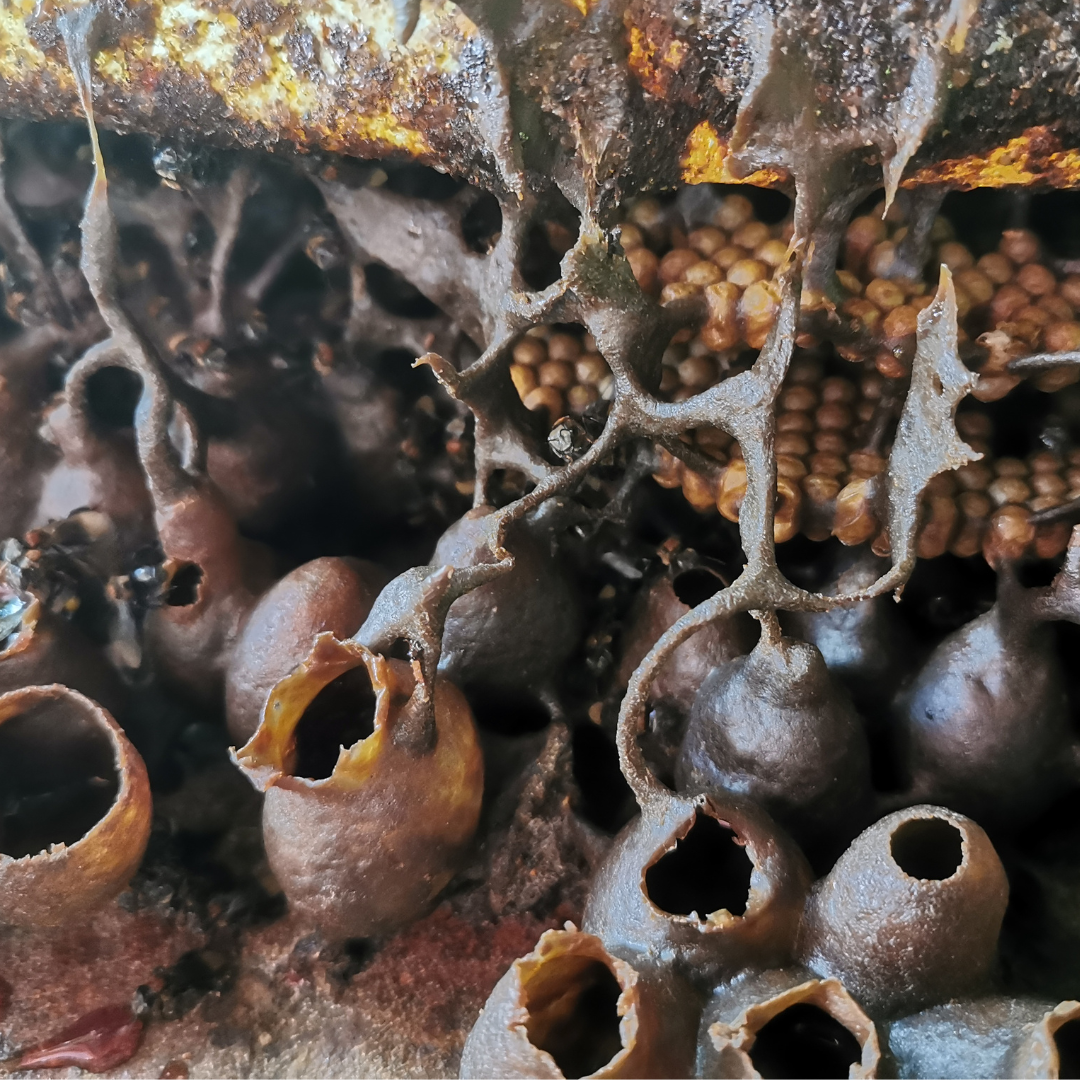Wasps and bees play essential roles in our ecosystems by pollinating and eating insects. Unfortunately, their homes can sometimes overlap with ours, which may cause them to be aggressive and sting people and pets. This is why it’s important to know what kind of wasp or bee you’re dealing with to know if they should be left alone or removed.
(Click the names to keep from scrolling)
If you have any questions or concerns or would like to schedule an appointment
Call Us Today! 952-404-BOGO (2646)
Share This Page!
Social Wasps in Minnesota
Paper Wasps in Minnesota

Appearance
Paper wasps are one of the largest wasps in Minnesota. They have skinny bodies and long legs. Their bodies vary between black and brown with yellow or black stripes and orange antennas.
Length: 0.75-1.0 inches

Behavior
Paper wasps are nicknamed the umbrella wasp due to their unique-looking nests. Every spring, they build a new nest under soffits, gutters, mailboxes, or anywhere that keeps the nest dry from rain. Their nests have multiple hexagonal cells that are used as cocoons for their larvae. It takes around 3 weeks for an egg to turn into a worker wasp. By the end of the summer, one paper wasp nest can have between 30-70 workers. Workers either forage for food or for nesting material. The foods that they forage for include nectar and fruits, and they hunt for different insects to feed to their larvae.
Nest Size: 30-70 workers
When Active: April to October
Yellow Jackets in Minnesota

Appearance
Yellow jackets are commonly misidentified as honey bees due to their size and color. Yellow jackets do not have as much fuzz on their bodies. Their abdomens have more yellow than black. They also have black antennas.
Length: 0.40-0.60 inches

Behavior
Yellow jackets are notorious for being aggressive and territorial. They are capable of stinging multiple times. They build their nest in various locations. Just a few areas include: inside trees and tree stumps, man-made structures, underground burrows, and papery aerial nests. They build all their nests from scratch each spring. By the end of the summer, their nest can have between 1,000-5,000 workers. Their diets consist of sugar found in fruits, nectar, and human foods. They also eat insects, and meat, and are considered scavengers for going after dead or decomposing organic matter.
Nest Size: 1,000-4,000 workers
When Active: April to October
Bald-Faced Hornets in Minnesota

Appearance
Bald-faced hornets are not hornets. They are related to yellow jackets and other social wasps. The reason why they are referred to as hornets is because of their aggressive nature and size. Their name comes from their predominantly white face. They also have predominantly black antennas, abdomens, and thoraxes.
Length: 0.5-0.65 inches

Behavior
Bald-faced hornets build aerial nests that are always at least 3 feet off the ground. Each of their nests is built in a teardrop shape. The top of the nest is wider and narrows at the tip where the entrance is located. By the end of the summer, their nests have between 400-700 workers. They often sting or attack people who invade their space. The higher up their nests are built, the less of a nuisance and threat they become to people and pets. They have smooth stingers that allow them to sting multiple times.
Nest Size: 400-700 workers
When Active: April to October
Solitary Wasps in Minnesota
Cicada Killer Wasps in Minnesota

Appearance
Cicada wasps are large, solitary wasps. Their thoraxes and abdomens have reddish-brown and black patterns on them. They also have brownish wings and light yellow stripes on their abdomens.
Length: 1-2.0 inches

Behavior
As solitary wasps, they are not as aggressive as social wasps are when defending their nest. They rarely sting unless they are stepped on, caught by hand, or stuck inside an article of clothing. They build their nest in underground burrows. They prefer to dig their burrows inside sandy or loose clay soils. They break down the soil using their mandibles and kick the loose soil out of the hole with their hind legs. They catch cicadas and bring them back to their nest. At the end of the summer, a female will pick a cicada to lay an egg inside it. When the egg hatches, the larvae will feed on the cicada before entering a cocoon for the winter.
When Active: July to August
Weevil Wasps in Minnesota

Appearance
Weevil wasps are yellow and black, but mostly black. Their heads are yellow in the front and black on top.
Length: 0.5-0.6 inches

Behavior
Weevil wasps dig underground tunnels for their nests. They often dig them in areas with loose soil. This includes places such as baseball fields, beaches, sidewalks, and roads. Inside the nest, a female lays one egg and flies off to find food for her larvae. A female weevil wasp catches and paralyzes a weevil or beetle with her venom. Because it’s paralyzed, it stays alive inside the nest for the wasp’s larvae to feed on before turning into an adult wasp.
When Active: June to September
Mud Dauber Wasps in Minnesota

Appearance
The two most common mud daubers in Minnesota are the common blue mud dauber (top) and the black and yellow mud dauber (bottom). They have a similar appearance with a narrow spine in between their thorax and abdomen. Their names describe the color of the bodies although the blue mud dauber has all-black wings and the black and yellow mud dauber’s wings are yellowish and black.
Length: 0.75-1.0 inches

Behavior
Mud daubers are solitary wasps so they’re not aggressive and rarely sting. They get their name from using mud to build their nests. They can be found near bodies of water collecting wet mud for nesting material. They commonly build them on homes and buildings that are stucco, brick, or wood. Their nests do not cause structural damage to homes and buildings. They build their nest to store their eggs. When a hole is visible on the nest the larva already turned into a wasp and will not come back to the nest. Females do not reuse old nests.
Blue Mud Dauber
When Active: May to August
Black and Yellow Mud Dauber
When Active: June to August
Bees in Minnesota
Honey Bees in Minnesota

Appearance
Honey bees have short hairs growing thicker behind their heads on their thorax. They are yellowish brown and have black stripes on their abdomen.
Length: 0.5-0.6 inches

Behavior
In the wild, honey bees build nests inside man-made structures, holes in trees, and cracks in rocks and retaining walls. They get the material for their nests from wax that they produce from the abdominal glands. They chew on it to make it more pliable and use it to form the cells for the hive. When protecting their nests, they lose their stingers and will die shortly after. They do not hibernate or die off like most wasps and bees do in the winter. Instead, they huddle closely together to stay warm and feed from their stored food supplies. This makes it possible for their nest to have 50,000-60,000 bees. All these bees play an important role in pollinating crops, flowers, and other plants during the spring and summer.
Nest Size: 50,000-60,000 workers
When Active: May to September
Bumble Bees in Minnesota

Appearance
Bumble bees are easily identifiable by their short hairs covering their entire bodies. Their hairs are black and yellow and are used to help them trap pollen.
Length: 0.25-1.0 inches

Behavior
Bumble bees build their nest underground, inside man-made structures, and in trees. Their nests can have up to 200-400 workers. Honey bee nests do not have the hexagonal cells that most wasps or bees have. Their nests are messy and disorganized. They are made out of wax that is produced by the queen and workers. The shape of their nests is often not visible due to their being underground or under heavy vegetation. Each nest is built from scratch every spring. The queen wakes up in the spring in search of a nesting location. Plants like dandelions and other weeds that are the first to bloom are crucial for the queen bee’s survival and for her to be able to reproduce and build another bumble colony.
Nest Size: 200-400 workers
When Active: April to October
Small Carpenter Bees in Minnesota

Appearance
Small carpenter bees have metallic blue or metallic bluish-green bodies. Their antennas are black when looking at them from above and brown underneath. They also have small pollen hairs on the tip of their legs.
Length: 0.25-0.30 inches

Behavior
Carpenter bees are solitary bees. They build tunnels or galleries inside wooden structures where they lay their eggs, store food, and use them as protection. Their tunnels are made into perfect circles just large enough for their bodies to fit inside. They make these tunnels using their strong mandibles that are capable of breaking down the wood. Their favorite wood to nest inside includes: oak, redwood, and pine. They are more attracted to old untreated wood that is soft and easy to chew through. They do not eat the wood, only chew through it. Their diets consist of pollen and nectar.
When Active: April to September
BOGO Provides Pest Control Services For the Twin Cities and Beyond!
Anoka|Apple Valley| Bloomington|Burnsville|Champlin|Chanhassen|Coon Rapids|Cottage Grove|Deephaven| Delano|Eagan|Eden Prairie|Edina|Elk River|Excelsior|Golden Valley|Independence|Lino Lakes|Long Lake|Maple Grove|Maple Plain|Maplewood|Medina|Minneapolis| Minnetonka|Minnetrista|Mound|New Brighton|New Hope|North Oaks|Orono|Prior Lake|Plymouth|Ramsey|Rogers|Roseville|Shoreview| Shorewood|Stillwater|St. Louis Park|St. Paul|Victoria|Waconia|Wayzata|White Bear Lake|Woodbury|
If you have any questions or concerns or would like to schedule an appointment
Call Us Today! 952-404-BOGO (2646)





